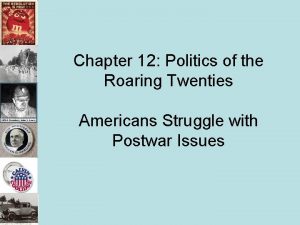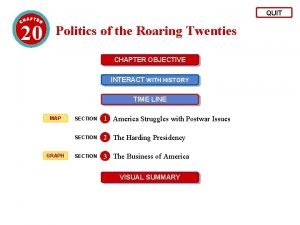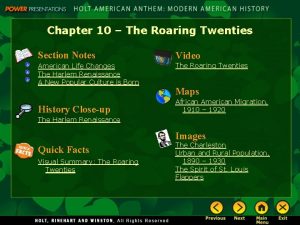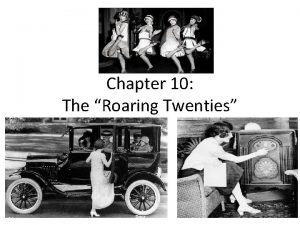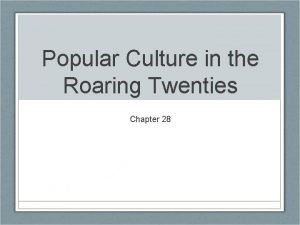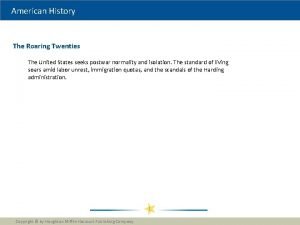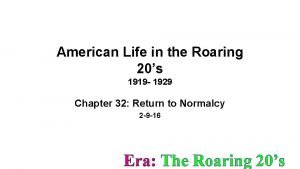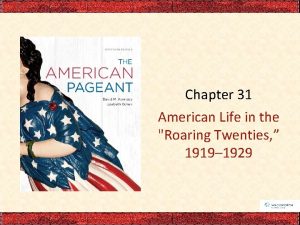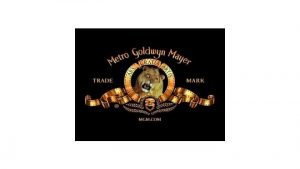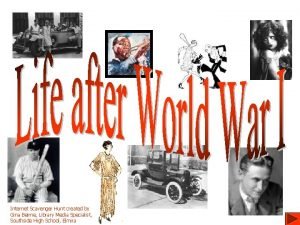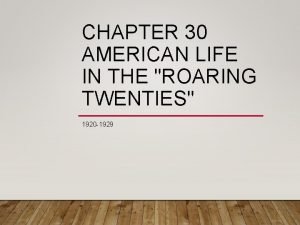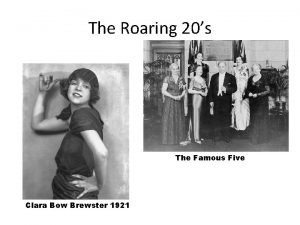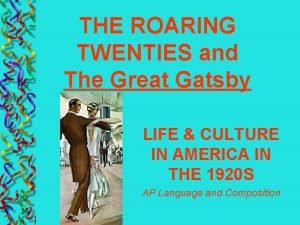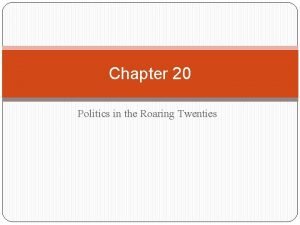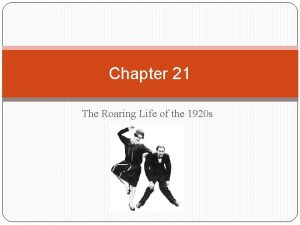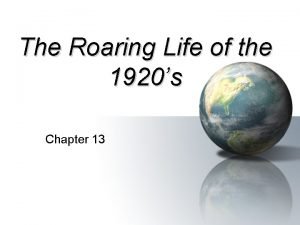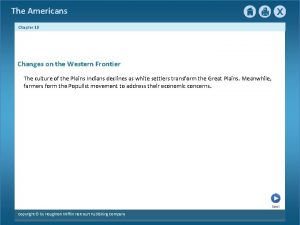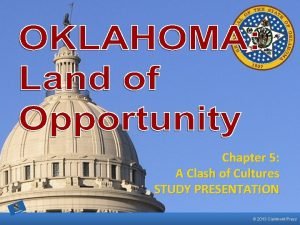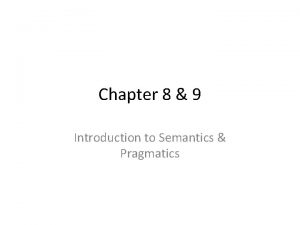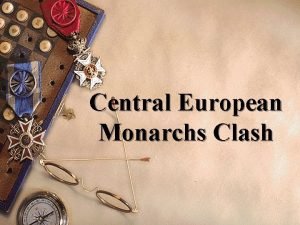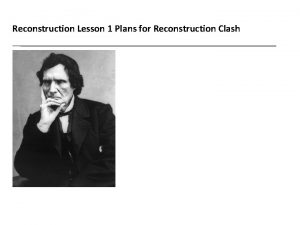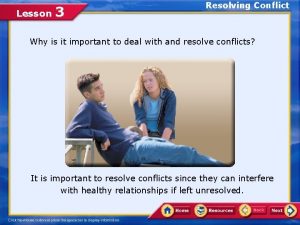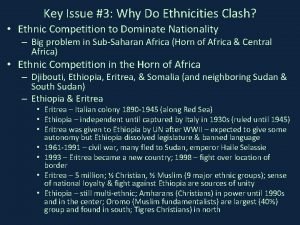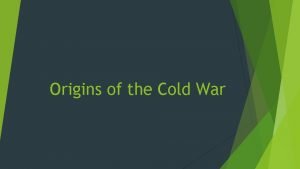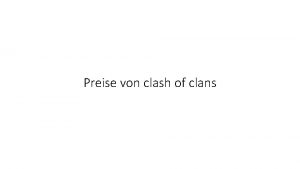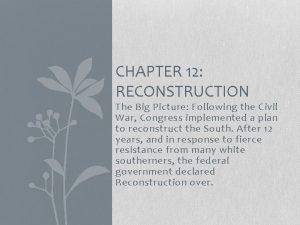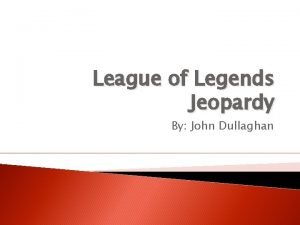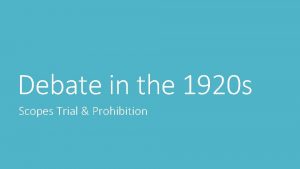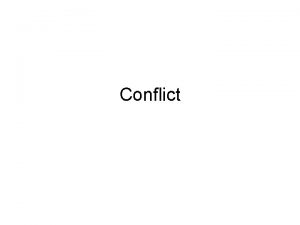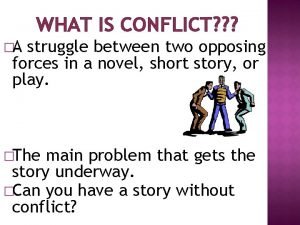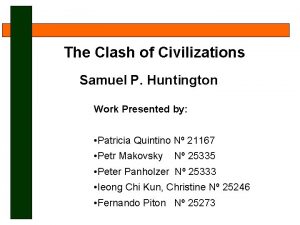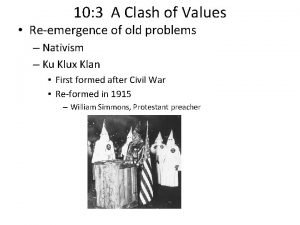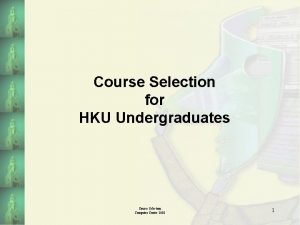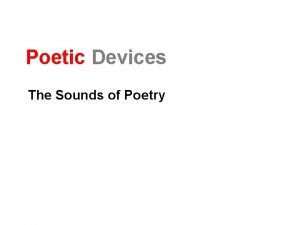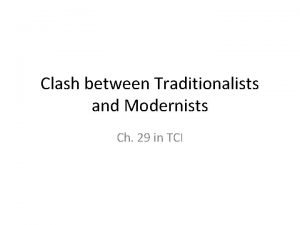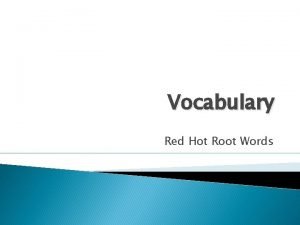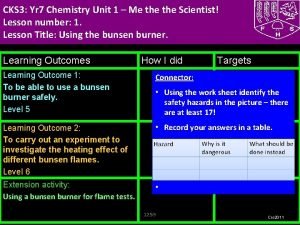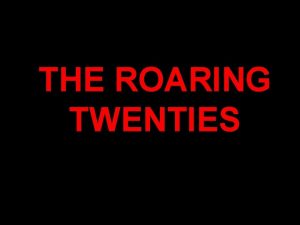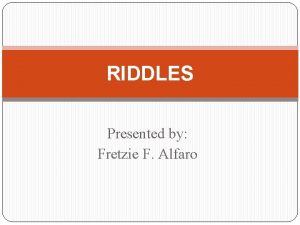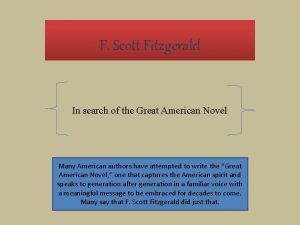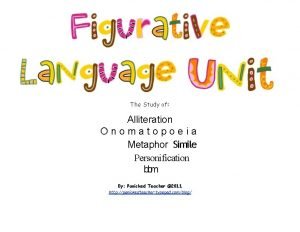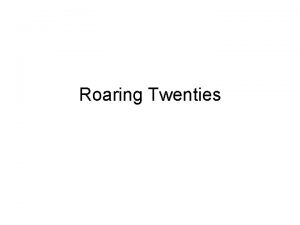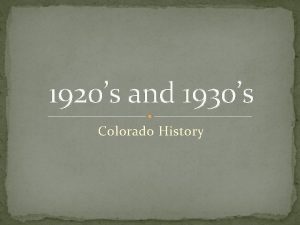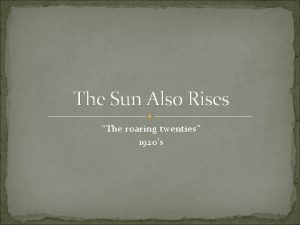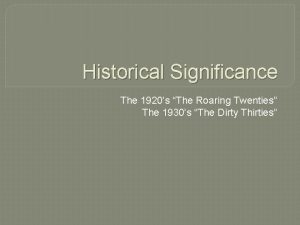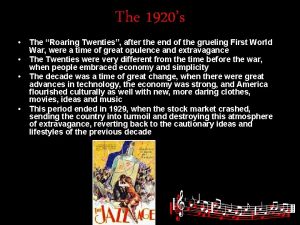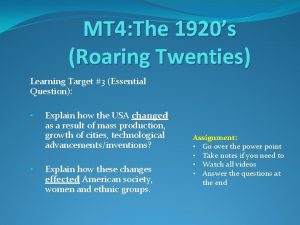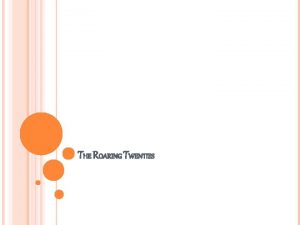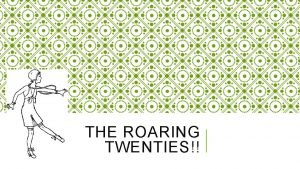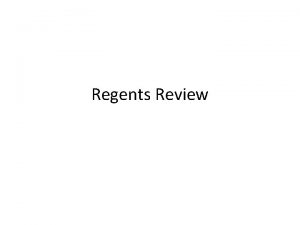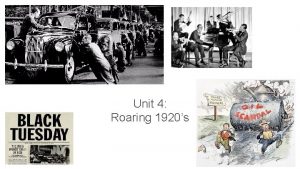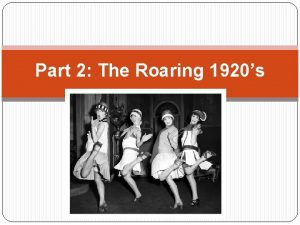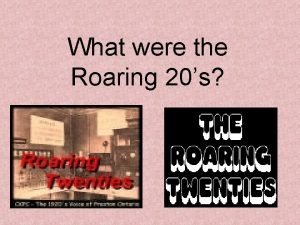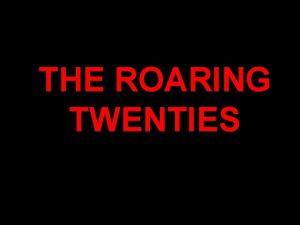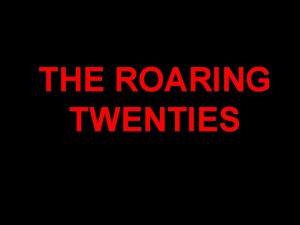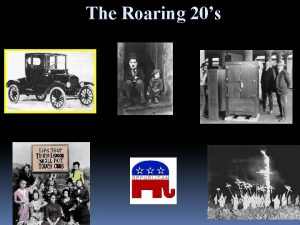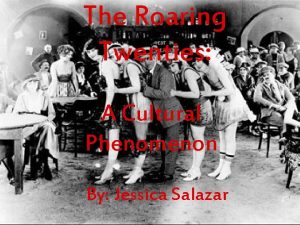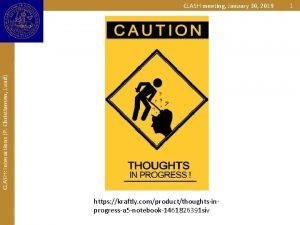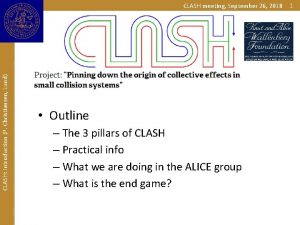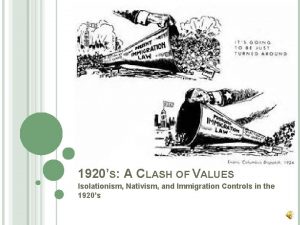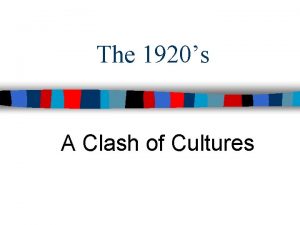The Roaring Twenties The 1920s Themes CULTURAL CLASH




















































- Slides: 52

The Roaring Twenties

The 1920’s Themes “CULTURAL CLASH” (“War of the Worlds”) Between the New Urban Industrial AGAINST the more Traditional Rural-Agricultural. The Battle was over Values. Materialism The “ROARING” ECONOMY of 1920’s But much of the “ROAR” was False Prosperity Unsound economic policies Disillusionment – Disgust about World War I Rejection of International Commitment = “Isolationist” Mentality.

1920’s: Culture Clash Old New Rural Urban Religious centered Science/technolog Slow pace of life y Fast paced life Changing roles Unraveling of society Traditional roles Social cohesion

A REPUBLICAN DECADE 29 th – Warren G. Harding – “A return to normalcy” 30 th – Calvin Coolidge (Silent Cal) – “the business of America is business” 31 st – Herbert Hoover (1921 -1923) (1929 -1933) (1923 -1929)

Conservative (Republican) Gov’t. & Politics (1920 – 1932) Return to Laissez faire: Very little regulation Tax breaks for rich & corporations Cut spending High tariffs to protect business Hawley-Smoot Tariff Harding – “Return to Normalcy” Teapot Dome Scandal with Standard Oil Coolidge – “The business of America is business”

Roaring ‘ 20 s was actually False Prosperity Brief post-war recession: No longer producing war goods, must demobilize Appearance of prosperity: more production rise in income low unemployment higher standard of living Areas of economic growth: auto/auto-related, construction, real estate, radio Not everyone is doing well: farmers, mining

The Changing Consumer

Mass Production Produced by assembly line More goods = cheaper goods Manufacturing output rose Henry Ford - His use of the 60% Assembly line Output per worker grew Made his Model-T affordable 33% Income grew by 30%

Impact of the Automobile Economic Steel, rubber, paint, glass, oil industries increase Roads begin to replace RR Social Crime patterns Sexual behavior Suburbanization Shopping centers Day trips and more vacations

Electricity and Production Leads to: Double business productivity New goods – #1 was the radio Others washing machine, stove, vacuum, refrigerator, iron Frees women from their typical household duties 1920=20, 000 1930=13, 750, 000

Consumerism Advertising (newspapers, magazines, radio) and movies give Americans desire for new goods Purchase appliances How can Americans afford these goods? Installment buying Paying for a purchase over a period of time with smaller payments “Buy now, pay later”

Effect of New Technology Homogenization Americans were more uniform Unites America People on both coasts share: Movies Radio programs Fashion styles Household products Increase interest in politics and sports Ends rural isolation Popularizes ragtime and jazz “The Jazz Age”

Nativism and new Racism

Nativism and new Racism A. RED SCARE (1919 -1920) – fear of Communists, aimed at Russian immigrants Palmer Raids B. Nativist Laws – lowered immigration from Southern and Eastern Europe Emergency Quota Act of 1921 National Origins Act of 1924 C. “new” KKK aimed at Jews, Blacks and Catholics and immigrants

Nativist laws passed to limit immigration Nativism – belief that native-born Americans are superior to immigrants. Chinese Exclusion Act of 1888 Emergency Quota Act of 1921 Lowered the amount of immigrants admitted to US = lowers immigration by 75% National Origins Act of 1924 Lowers immigration specificially from Eastern and Southern European Countries Why Eastern and Southern Europe? Language and religious differences, political ideas

YEARS World War I U. S. Industrial Revolution German Militarism Economic Depression in U. S. Railroad Building Western Settlement U. S. Civil War Famine in Ireland Revolution in Germany NUMBER OF IMMIGRANTS (in thousands) INFLUENCES ON IMMIGRATION TO THE UNITED STATES (1820 -1940)

Sacco and Vanzetti Trial - 1921 Italian Immigrants who are anarchists Convicted of murder and executed - 1927 The major questions are: Did they received a fair trial Were they guilty of murder or of being Italian and anarchists? ? Displays the intolerance “Anarchist Bastards!” – Judge Thayer

Prohibition

Culture Clash! Prohibitionist / Rural v. Anti- Prohibition / Urban Alcohol is blamed for? poverty crime abuse Unproductive workers/unemployed disease Progressive Era – alcohol monopolies are big business and are corrupt!


Prohibition Movement = Temperance Movement Led by women and religious groups - WCTU 18 th Amendment passed in 1920 – illegal to manufacture, transport, sell The Volstead Act = anything over. 5%abv is illegal Leads to: everyday citizens breaking the law Leads to Organized Crime Al Capone

Moonshine Distilling Bathtub Gin

Prohibition Terms Bootlegging Illegally making or importing alcohol Speakeasy Secret Bars which sold alcohol Tax Evasion Not reporting income = you don’t pay taxes Money Laundering Cleaning money by sending it through legitimate companies

Al Capone The Untouchables Trailer

The End 21 st Amendment Repeals the 18 th Amend. ends Prohibition in 1933 Unpopular law is difficult to enforce

Culture Clash Urban (Science, Change) v. Rural (Religion, Tradition) Flappers and Women’s Rights Harlem Renaissance Scopes “Monkey” Trial

Flapper A woman with a liberated lifestyle Smoking Drinking Dancing Seductive clothes and make up Attends parties

REALITY Roles of women in society 10. 5 million working in 1930 Outside work still menial jobs – teacher, clerk, retail 90% still at home Stereotypes still exist Men are superior in thought and ability, women should just stay in the home and their gender role MOST WOMEN ARE NOT FLAPPERS! Small % of women actually were flappers Some of their behaviors do become acceptable over time

First Americans to Protest in front of the White House, were arrested for obstructing traffic and put in jail.

Women’s Suffrage Motivations Ever since Seneca Falls Convention (1848) Western states had allowed women to vote in local elections in late 1800 s Contributions in WWI 1920 – 19 th Amendment – women’s right to vote Women vote in 1920 election Do not vote in large numbers or in unity League of Women Voters Created to help encourage women to vote

Jeanette Rankin • First Woman elected to the U. S. Congress (1917 -1919) • Pacifist, Feminist & Social Reformer • Republican

The Harlem Renaissance

“Great Migration” (1917 – 1930) African Americans begin to move north (Harlem, Chicago, Detroit, Boston) Jobs during WWI New opportunity besides farming African Americans were hoping to find an end to discrimination Race riots in Chicago and other cities KKK is active again – targets A-A and immigrants



Southern Lynching

The Harlem Renaissance A rebirth into racial heritage and backgrounds Blending of African. American cultures to establish/find true identity Led by intellectual African Americans Well educated and middle class Felt alienated from society Called for action against bigotry Expressed pride in African American Culture and identity Through: books, poems,

Harlem in the 1920’s

Langston Hughes -Great American Poet ONE WAY TICKET I am fed up With Jim Crow laws, People who are Cruel And Afraid, Who lynch and run, Who are scared of me And me of them. I pick up my life And take it away On a one-way ticket Gone up North Gone out west Gone! -1926

Duke Ellington • Giant of Jazz Music • Great Orchestra leader Bessie Smith • Jazz Singer • Known as “The Empress of the Blues”

Louis Armstrong

The Cotton Club

The Lasting Effect Creates new music Great Literature - * Langston Hughes * During the civil rights movement of the 1960 s writers of the Harlem Renaissance will see a renewed interest “We build our temples for tomorrow, strong as we know how, and we stand on the top of the mountain, free within ourselves. ” o Langston Hughes

John Scopes Taught the Theory of Evolution

The Lawyers Defense – Clarence Darrow State Prosecutor – William Jennings Bryan

City v. Rural and Science v. Religion Scopes “Monkey” Trial (1925) Tenn. Law prohibits teaching theory of evolution Must teach Creationism from Bible John Scopes is a Biology teacher in Tennessee on trial for teaching evolution Scopes was convicted (found guilty), fined, but a higher court overturned it Illustrates the culture clash of Rural/Religion v.

The American Celebrity

Charles “Lucky” Lindbergh Solo Flight across the Atlantic Ocean = America’s most famous hero!


Charlie Chaplin -Great Silent Film Comedian -His “Little Tramp” Character was Legendary -Accused of being a Communist he left America in 1952

Babe Ruth “The Bambino” -Great Home Run Hitter for the NY Yankees -Hit 60 HR’s in 1927, 714 Lifetime

Cultural Icons and Other Heroes: First Decade of the “Celebrity” in American history A. Charles Lindbergh’s solo flight across the Atlantic was America’s most famous hero. B. Sports legends like Babe Ruth, Red Grange, Jack Demsey and earned the attention of adoring fans. C. Literary Greats like F. Scott Fitzgerald, Ernest Hemingway and Sinclair Lewis charmed readers with a new kind of literature. D. “Movie Stars” became famous: Charlie Chaplin, Mary Pickford E. Jazz sound entertained American fans; Jelly Roll Morton, Duke Ellington, Louie Armstrong F. “Harlem Renaissance” occurred: New Black “pride” reflected
 Chapter 12 politics of the roaring twenties
Chapter 12 politics of the roaring twenties Chapter 20 politics of the roaring twenties answer key
Chapter 20 politics of the roaring twenties answer key Chapter 20 politics of the roaring twenties
Chapter 20 politics of the roaring twenties Chapter 10 the roaring twenties
Chapter 10 the roaring twenties Chapter 10 the roaring twenties
Chapter 10 the roaring twenties Chapter 28 popular culture in the roaring twenties
Chapter 28 popular culture in the roaring twenties The roaring twenties lesson 3 changing ways of life
The roaring twenties lesson 3 changing ways of life Roaring twenties acrostic poem
Roaring twenties acrostic poem Chapter 31 american life in the roaring twenties
Chapter 31 american life in the roaring twenties The roaring twenties were characterized by-
The roaring twenties were characterized by- The roaring twenties canada
The roaring twenties canada Five effects of the great depression
Five effects of the great depression Chapter 30 american life in the roaring twenties
Chapter 30 american life in the roaring twenties Roaring twenties acrostic poem
Roaring twenties acrostic poem Roaring twenties great gatsby
Roaring twenties great gatsby Chapter 20 politics of the roaring twenties
Chapter 20 politics of the roaring twenties Chapter 21 the roaring life of the 1920s
Chapter 21 the roaring life of the 1920s Chapter 13 the roaring life of the 1920s
Chapter 13 the roaring life of the 1920s Chapter 13 section 1 cultures clash on the prairie
Chapter 13 section 1 cultures clash on the prairie Chapter 5 a clash of cultures
Chapter 5 a clash of cultures Chapter 5 section 3 central european monarchs clash
Chapter 5 section 3 central european monarchs clash Semantic clash
Semantic clash Central european monarchs clash
Central european monarchs clash Andrew johnson reconstruction plan
Andrew johnson reconstruction plan Lesson 3 a clash of values
Lesson 3 a clash of values Why do ethnicities clash
Why do ethnicities clash Mc formers
Mc formers X bogen clash of clans
X bogen clash of clans Why did johnson and congress clash over reconstruction
Why did johnson and congress clash over reconstruction Hapsburg triumphs
Hapsburg triumphs Balanceamento clash
Balanceamento clash Clakey d
Clakey d What clash does the scopes trial represent?
What clash does the scopes trial represent? This is the struggle between opposing forces.
This is the struggle between opposing forces. The struggle between two opposing forces
The struggle between two opposing forces Clash of civilizations huntington
Clash of civilizations huntington Clash of lights 10
Clash of lights 10 Hku course disapprove
Hku course disapprove Drip hiss the rain never stops
Drip hiss the rain never stops Chapter 29 the clash between traditionalism and modernism
Chapter 29 the clash between traditionalism and modernism Clash royale clan manager
Clash royale clan manager Clash of armies
Clash of armies Clash of civilizations huntington
Clash of civilizations huntington Col to come together with great force to clash
Col to come together with great force to clash Roaring flame bunsen burner
Roaring flame bunsen burner Roaring 20s vocabulary
Roaring 20s vocabulary Here comes kaka walking with an open leg
Here comes kaka walking with an open leg Romeo and juliet act 4 scene 1 quotes
Romeo and juliet act 4 scene 1 quotes The roaring 20’s / jazz age
The roaring 20’s / jazz age What is personification
What is personification Demobilization roaring 20s
Demobilization roaring 20s Roaring rockets powerpoint
Roaring rockets powerpoint 20s decade fashion
20s decade fashion
